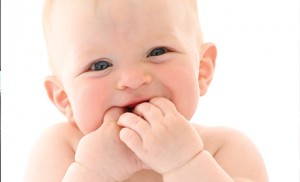Sometimes moms and dads can lose sight of self-purpose when they find themselves day in and out with a baby. “The first three years of a child’s life are crucial to a child’s development as the neural connections are being made at a more explosive rate than any other time in their life,” says Casey Reed, Director at Children’s Meeting House Montessori School. “Who and where a child spends these years will make a world of difference in their brain development. Bonding and play through games and joyful interactions help children feel safe and loved, which is a fundamental need of all human beings. Babies seek interaction and play through their senses, so utilizing touch, visual, auditory, olfactory, and taste help them to decode the world around them.” This is important work! Make the most of it by encouraging Baby’s development through simple games and activities.
6 months+
Touch and Feel (Show and Tell!)
Spend early playtime days showing your baby different objects. Show Baby anything that’s safe! Spoons, whisks, books and magazines with pictures, record albums, colorful fabrics or clothes, fruits and vegetables, and so on.
Keep a little stash of objects beside you and sit with Baby. Hold an object about a foot from his face and stare at it together, telling him about it.
Now it’s reading time … bring out a board book and let him touch. While he probably won’t sit through a story right away, he eventually will. Then he’ll develop favorite books and stories. Babies love looking at books and cuddling with you, and to keep him interested in books, use different voices and modify stories as needed!
Peek-a-boo!
At about 6 months old (or sooner, depends on the baby), take a floaty scarf and fling it into the air, letting it settle on your baby’s head. As he gets older, you may notice him starting to play with other items like blankets or towels.
Variations on peek-a-boo:
The classic: Hold up a towel between your face and your baby’s, and ask, “Where’s Jack? There’s Jack!” over and over again. You can vary this game in a million ways. Hide behind a door and make your baby push it open to see you. Hide behind a chair and pop out first from above then from the sides. Go behind a corner with another person and alternate who gently coos, “Boo!”
Keep a selection of hats and pop up wearing a different one each time. Another giggle-getter is to put a hat on your head, low enough to cover your eyes, and let your baby take it off, saying “Oh!” in surprise each time he does it.
Sing Songs
It doesn’t matter one iota if you don’t like your singing voice; your baby does. Now’s the time to sing away.
“The Wheels on the Bus,” “Row, Row, Row Your Boat,” “Head, Shoulders, Knees and Toes,” and “Patty-Cake,” to name a few. (If you don’t remember the words to a favorite song, just look online.)
You may feel silly at first, but keep at it. As your child gets into it, so will you. Try adding your baby’s name to the song: “Old Mac Jackie had a farm,” “Kate is my sunshine, my only sunshine,” and so on. Try songs with silly sounds or animal noises in them, like “How Much Is That Doggie in the Window?”
Bubbles, Bubbles Everywhere
There’s something magical about bubbles, and at 6 months your baby can see far enough away to focus on them. Blow bubbles when he’s getting fussy and watch the tears dry up. Blow bubbles in your backyard or at the park where other little ones may come along and entertain your baby in the process. Blow bubbles in the bathtub or out on the porch when it’s late afternoon and your baby is cranky. Bubbles are cheap and easy to take along wherever you go.
This Little Piggy
This little game goes way, way back. With a barefoot baby on your lap, wiggle one of his big toes and say, “This little piggy went to market,” then move on to the toes next to it and say, “This little piggy stayed home,” and move through each toe with, “This little piggy had roast beef,” “This little piggy had none,” And … on the last teeny toe squeal, “This little piggy went wee-wee-wee all the way home!” As you say that last part, run your fingers up your baby’s belly. Giggles all around!
Tummy Time
It’s important to have your baby spend time on his tummy, even if he protests vociferously.
Get down on the floor with your baby. Look at him as you lie on your own belly. Lay your baby down on a towel and use it to gently roll him from side to side. Try saying, “Oops-a-daisy, oops-a-daisy” as you roll him.
Fly, Baby, Fly!
Now that your baby can hold his head up, it’s time to hoist him into the air. Pretend he’s a rocket ship, flying him over you and making realistic rocket noises. You can also play like your baby is in an elevator, which advances up floor by floor before sinking quickly to the bottom.
Touch It, Hold It, Bang It
If your baby has one object, he’ll bang it on the table. If he has two objects, he’ll bang them together! Just make sure you give him bangable objects and do it with him. Bang them separately on the table, hit the table with both at the same time, see if the object sounds different when hit using the left hand rather than the right hand, and so on.
Help him by handing over objects that make interesting sounds: hollow containers, metal spoons, bells.
Pay attention to tactile sensations as well: Your baby will be fascinated by the way different things feel.
Roll Play
Babies are fascinated by balls and how they move. You’ll get a big laugh by juggling or tossing balls up in the air and letting them hit the floor while you make a silly sound effect: “Whoops!” Roll a soft ball toward your baby and watch him grab and squeeze it. Eventually, with encouragement, he’ll roll the ball back toward you. Someday, he’ll be able to kick and toss the ball or drop it into a big bowl or bucket. For now, bounce and roll.
8 months+
Rearrange and Re-rearrange
Your baby is figuring out the connections between objects in the world. He’ll love to stack and arrange objects, as well as fill and empty them. Give your baby a box that’s easy to open (like a shoe box) and show him how to put things in and take them out. Another way to play this game: Get a bunch of cups (stackable measuring cups work great) and show your baby how to pour water, sand or cornmeal from one to the other, or into a larger container.
Cruisin’
Once your baby is up on his feet, you can encourage cruising by placing a favorite toy at the far end of the couch or over on the coffee table. Try enticing your baby by putting one of your toys, such as your phone or sunglasses, a distance away and cruising on your knees toward it. Your baby may find this amusing and attempt to join you.
Encourage your baby to push an object around the room. Push toys and large empty boxes work well. Avoid folding chairs, which can fold up unexpectedly.
The Bath Is Fun
No longer is your baby content to sit in the tub and be washed. Older babies want to stand up, splash, grab your hair, pat the shower curtain and so on. (Note: Never leave a baby unattended in the bath, not even for a minute.) Encourage the fun by adding lots of toys to the tub. Plenty of stuff around the house can be endlessly filled, drained, poured from or into, and floated. Poke holes in the top of a plastic bottle with a flat cap to make a homemade watering can. Let your baby feel the sensation of the water dripping onto him and show him how to cut off the flow by blocking it with his hand. Use your homemade toy to give his rubber ducky a shower.
At the end of the bath, drain the toys in a plastic colander or a net bag suction-cupped to the side of the tub. Hopefully your baby is clean, happy and ready to sleep. Wasn’t that fun?
Sources: Playful Parenting by Lawrence Cohen (Ballantine; 2002) and The Happiest Baby on the Block by Harvey Karp, M.D. (Bantam; 2013)





